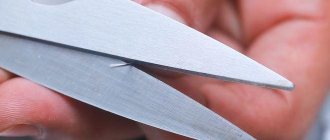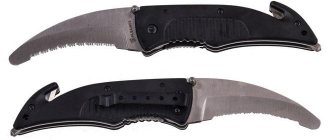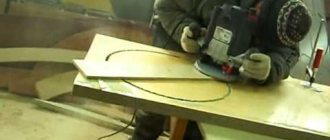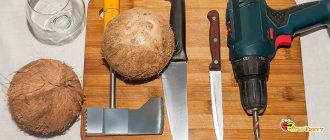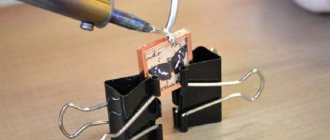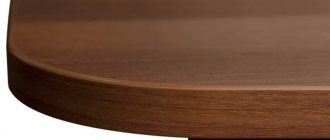A knife is a necessary tool in every kitchen. Different materials are used for its manufacture. Today, ceramic products are often found on sale. They are quickly gaining popularity because... do not require frequent sharpening and are attractive in appearance. Still, it wouldn’t hurt to learn how to sharpen a ceramic knife at home.
Practicality of ceramic knives.
What is the difference between ceramic knife blades and metal ones?
Zirconium dioxide is used to produce ceramic blades. This is a very hard material used in medical and space technologies, in high-tech enterprises. The material has nothing to do with conventional ceramics; it is called zirconium ceramics due to its production technology.
The blade is fired at high temperature in a special oven. Unlike their metal counterpart, they do not need to be sharpened every month. The ceramic knife retains its sharpness for up to one year of daily use.
The blade can be white or black. The black color of the product comes from zirconium carbide, and the white tint comes from zirconium dioxide (ZrO2). In China, this substance was nicknamed “brother of diamond” for its properties. For comparison, the Mohs hardness of steel is 4-7 units, zirconium ceramics is 8-9 units, and diamond is 10 units. Wear resistance exceeds metal knives by 80 times.
The main difference between zirconium ceramics and other materials is its enormous heat resistance and strength. According to these physical indicators, ceramics are several times higher than most steel grades. Also, zirconium oxide does not react with alkalis, acids and other active substances. But there are also disadvantages that you should know about before purchasing the product.
| Advantages | Flaws |
| The blade is much harder than steel, cuts food better | Factory sharpening of ceramic knives is worse than that of metal counterparts |
| Remains sharp for a long time | They do not withstand impacts; they can simply break or crack. |
| There are no scratches on the surface of the blade, and the knife itself retains its original appearance for a long time | It is better not to wash in the dishwasher |
| Can be easily washed | Cannot tolerate physical stress on the fracture |
| Does not spoil the taste of products due to oxidation that occurs on the metal | the material absorbs liquids and may change color over time |
There is no clear answer to the question of which material is better, steel or ceramics. Each of them has its own characteristics, because they are completely different substances. Many users continue to cook using steel knives the old fashioned way and are not going to overpay for an expensive new product. And those who have tried ceramic ones are no longer ready to return to metal blades.
Nuances of care and operation
To ensure that your knives last as long as possible and do not become dull, you need to adhere to the following recommendations:
- Do not cut extremely hard foods such as bones or frozen meat.
- When slicing, perform smooth, even movements as even as possible.
- Use a cutting board made of wood.
- Do not hit the working area with the tip of the device.
- It is not recommended to scrape vegetables and fruits.
- It is important to wash the product by hand in warm water; the dishwasher is not suitable for ceramics.
- Try not to drop the tool.
- Avoid sudden temperature changes.
- Store separately from kitchen utensils made of metal.
Ceramic knives require special care. True, even with careful treatment of them, sometimes there is a need for sharpening. You can perform this procedure yourself. To do this, you just need to choose the right knife and strictly follow the instructions.
Do not use a ceramic knife to cut bones or frozen meat.
It is advisable to use a cutting board made of wood
It is not recommended to scrape vegetables and fruits
Knives with ceramic blades should be stored separately from kitchen utensils made of metal.
How to correctly calculate the sharpening angle
A steel blade can be sharpened by eye; this will not affect its properties in any way. But a zirconium dioxide blade will not tolerate such treatment; a mistake can ruin it beyond repair. You can determine the exact sharpening angle of the blade using a special device - a protractor; it is better to use an electronic version, for example, an inclinometer with a magnetic base.
This value is called the plane of the cutting edge in relation to the axis of the blade. The smaller the angle, the sharper the blade, but the wear resistance decreases. With a large sharpening angle, there is less chance of ruining the edge, but an even thin cut will no longer be possible.
You can return the original sharpness without a protractor. A universal recommendation for sharpening all ceramic knives is an angle of no more than 25-30°. Chef's knives for preparing Japanese cuisine require no more than 20°. When sharpening again, it is better to keep the factory settings unchanged, otherwise the product will quickly become dull, chips and other defects will appear.
Unlike a metal blade, you should not press too hard on a ceramic product while sharpening.
Advantages and disadvantages of ceramic products
Advantages of ceramic knives:
- blade sharpness;
- neutrality;
- environmental cleanliness;
- light weight;
- chemical resistance.
The sharpness of the blade, which contains zirconium dioxide, is accompanied by the fragility of the material. Zirconium dioxide ranks third in hardness after diamond and corundum, which are in first and second place.
For a long service life, you need to ensure proper operation of the ceramic product. Ceramic knives differ from their steel counterparts in that they do not oxidize and do not affect the taste and color of the processed products.
Environmental friendliness allows us to recommend this tool for preparing baby food. The tool is lightweight, with its help you can cut food quickly and beautifully without feeling tired. A metal blade becomes covered with rust and stains over the years. This does not happen with ceramic products.
They are not afraid of hot water, detergents, household chemicals, and are scratch-resistant.
Flaws:
- great fragility;
- high price;
- lack of versatility;
- difficulty of sharpening.
It is not recommended to use sharp ceramic products to cut hard foods. The fragility of the material does not allow cutting bones and cartilage or opening cans. The blade breaks even when you try to bend it with your hands.
Ceramics are more expensive than metal, so knives are not cheap, nor are they versatile. The tool is used in the kitchen, but is not suitable for camping. It is suitable for cutting soft meat, vegetables and fruits.
How to sharpen ceramic knives
It is important to know which side the blade is sharpened on - one or both. The position of the blade when sharpening the knife depends on this. Ceramic knives should be sharpened with care, remembering that this material is fragile and can easily crack. There are a number of recommendations for caring for a ceramic knife:
- You need to sharpen your blade no more than twice a year.
- If the knife is not used every day, once is enough.
- Black and dark blades are stronger and sharper than their white ceramic counterparts.
- If you doubt your abilities, it is better to entrust the task to a professional.
We recommend: How to properly peel fresh, boiled and frozen shrimp at home?
There is one trick to determine if the blade is dull. It's worth trying to cut a sheet of plain paper. If it is difficult to cut or simply wrinkles, it’s time to sharpen the knife. Ceramic knives will have to be sharpened at home more often than twice a year - unless special machines are used, it is difficult to bring the blade to the required sharpness. Available tools are suitable for this purpose.
Single-sided sharpening
The first ceramic knives from Japan were intended for cutting food into thin slices, and the blade was sharpened only on one side. It will be convenient for a left-handed person to work with such a knife; you just need to choose a product with a properly sharpened edge. Such specimens were sharpened in the following order:
- the edge on the wedge-shaped side is sharpened until burrs appear on the blade;
- the knife is turned over to the other side, the burrs are ground off;
- The final sharpness is achieved using a diamond stone.
After such manipulations, the knife retains the sharpness of its cutting edge for up to six months.
Double-sided sharpening
Sharpening on both sides is different from one-sided. First, work is carried out on one side until even burrs appear. The knife is then turned over and then the other side is sharpened. Afterwards, the blade is brought to perfection with a fine-grained diamond stone.
What sharpening options are available at home?
Is it possible to sharpen a ceramic knife from different sides? If you use special pastes, diamond wheels or sharpeners, you can easily create a cutting edge on either the right or left side of the knife, depending on which hand you hold the knife in while working.
If your tool is used by all members, it is advisable to make a universal sharpening. To do this, you need to process the blade on both sides equally.
The better to sharpen
Not every material can cope with sharpening a ceramic blade. Cheap silicon carbide sharpening stones are not suitable for this purpose. You should choose an abrasive with a grit of about 320 units. Abrasive compounds with diamond chips have proven themselves to be the best.
If you don’t have enough experience in sharpening knives, a suitable method for restoring sharpness is using a universal sharpener. This method has several advantages:
- safety (the risk of cutting a person during sharpening is minimal);
- reliability (it is extremely difficult to break the blade in this case);
- The sharpening angle is selected automatically.
Such a device can be mechanical or electrical. When choosing it, you need to know which side the knife is sharpened on. While working, it is worth remembering that ceramics is a fragile material that can break if there is excessive pressure on it.
Musat
Musat is not suitable for sharpening very dull knives due to its low efficiency. It is used when the blade needs to be slightly sharpened to restore its sharpness. The process consists of several successive stages:
- The musat is in an upright state and rests firmly on a solid base.
- The blade is moved along its surface with slow smooth movements.
- The pressure on the knife is light, a little stronger towards the end of the blade.
The movements are repeated until the sharpness of the cutting edge is restored. It is worth choosing a product with a diamond rod. This material easily removes even microscopic nicks on the edge of the blade. There are also hybrid or mixed musats. On both sides they are coated with abrasive diamond coating, on the third - with thin aluminum ceramics for straightening the blade.
Diamond block
A diamond stone is more effective than a regular stone and allows you to get very good results. However, the procedure is more complicated and takes longer. To sharpen a knife, you need to follow the following algorithm:
- To sharpen, you need to reproduce the following algorithm of actions:
- The block needs to be soaked in water for about 30 minutes.
- Calculate the trajectory of the knife and what movements you can use to sharpen it to achieve maximum sharpness.
- The angle is within 20-30°, and this should be adhered to when working with a knife.
We recommend: Cleaning the washing machine filter - simple and necessary tips
First, all the work takes place on one side, then on the other. The exception is specimens that have a one-sided sharpening. The finely powdered side of the whetstone is used to sharpen the cutting edge. The coarse abrasive part removes small nicks on the blade.
Electric sharpener
The device is equipped with two small diamond-coated disks. The sharpener will automatically adjust to the thickness of the blade and its sharpening angle, maintaining these parameters during the entire process of working with it. This method does not take much time, providing quality no worse than professional. If a person does not have experience sharpening knives, this option can be called the best, as it has a number of significant advantages:
- automatic angle selection without human intervention;
- blade sharpness after work;
- high level of safety for humans.
The best models are produced in the USA and Japan. But such models have a high cost. There are cheap variations in the form of a manual knife with a plastic body. It will also allow you to maintain the factory sharpening angle, but you will have to rotate the discs yourself. Manual sharpening will require more time and effort, but will save on the cost of an electric sharpener.
Manual sharpener for ceramic knives
The principle of operation is similar to the electrical analogue, but a lot will have to be done by hand. Some models have the ability to set the angle by default. The cost of such a device is low, but when choosing, you need to pay attention to the maximum thickness of the blade.
Diamond paste
This paste contains tiny particles measuring 5 microns. It is applied to the cardboard, and then the knife blade is rubbed with it. This kind of work takes a lot of time and requires a lot of effort from a person, but the result will be excellent. This material is used to polish the surface of a ceramic knife. For sharpening a blade, this is not the best method, like a sharpener or a stone.
Specialized machine
There is special equipment for sharpening - an electric sander. But working with it requires experience and some special knowledge. Working with such a machine is carried out in this way:
- for work you will need diamond discs with different grain sizes;
- At first, the blade is processed coarse-grained, then gradually this figure decreases;
- the disk speed is gradually reduced so as not to damage or break the knife;
- Sharpening starts from the base of the blade closer to the handle, moving to the end.
During work, you need to ensure that the sharpening angle is maintained, being in the range of 25-30°. At the initial stage, the angle can be reduced to 10-15°. This way you can achieve a sharp blade, but it will not last long.
Self-sharpening methods
An affirmative answer to the question of whether it is possible to sharpen a ceramic knife will be given in any specialized workshop. The ceramic blade is highly durable, so regular tools for sharpening metal will not work . You will need diamond-coated tools or CBN emery. You can buy a special electric sharpener (preferably made in Japan), which guarantees perfect sharpening. It is expensive, so it is worth purchasing it if you use several ceramic knives in the kitchen.
A manual sharpener or a sharpener (a round or faceted metal block attached to a handle) will be cheaper. You can use diamond paste, but then the work will take much longer. An indispensable condition during the work process is that the surface must be wet. It is recommended to pre-soak the sharpening discs in water for 10 - 15 minutes and regularly moisten them during work .
The process will require certain skills and dexterity. If the blade becomes chipped, it will be almost impossible to restore it. Before starting work, you need to clarify the type of sharpening. Original Japanese knives have a one-sided sharpening, while European versions have a double-sided sharpening.
Electric sharpening machine
Sharpening a ceramic knife with a machine contains many subtleties, but the main rule is that the blade is processed only at the lowest speeds. When performing these steps, you should not press the blade too hard against the surface of the diamond, but do not hold it loosely either. It is best and safest to hold the belt so that it is firmly pressed and in full contact with the running surface of the wheel without bouncing or peeling.
The technique used to manipulate a ceramic blade differs from that of a metal blade. You need to start sharpening the product near the handle itself, carefully pressing the blade against the wheel rotating at low speed and slowly moving it from the base to the tip. In this case, don't limit yourself to one pass.
For maximum effect, the knife must be processed at least 5-7 times, then turned over and repeat all manipulations from the very beginning. Only after this will the ceramic knife acquire the necessary sharpness and restore its external shine, and the blade will again become monolithic and uniform.
Electric sharpener
It is a small device equipped with a pair of small diamond blades. The drives are powered by an electric motor. Powered by AA battery or rechargeable battery. To sharpen, insert a knife blade between the discs. The quality of sharpening the blades in an electric angle grinder is quite high - even very dull blades can be returned to their original state. The main advantage of an electric sharpener is ease of use. The main disadvantage is the high price.
All you have to do is install the blade into the machine and secure it at a right angle. In some models, the blade is not fixed, but is periodically moved into the groove of the device.
If you'll be sanding with an electric machine, set the speed to low, runout to a minimum, and watch the angle carefully.
Hand sharpener
Anyone who has ever sharpened regular knives can work with a manual sharpener. The process is simple, but will take more time.
When sharpening a product with a single-sided blade, first sharpen the side that acts as a wedge, while the burrs on the cut surface should be uniform. Then the blade needs to be turned the other way to grind off the resulting burrs.
If the product is double-sided, then one side is sharpened first, then the other. With strict adherence to symmetry. At the end of the work, a fine-grained stone is used to give the cutting surface greater sharpness.
Diamond paste
Another option for sharpening ceramics with your own hands is to use diamond paste, which is applied to the blade. Moreover, the size of its grains should not be more than 5000 microns or even less. It is these indicators that allow optimal work on the handpiece, helping to restore lost characteristics and its functionality.
Bar
A ceramic knife can be sharpened at home by hand, without using any technical equipment. As a rule, bars of different grain sizes are used to provide the required parameters. Optimal conditions for polishing and straightening the blade are grains of at least 6000 microns. In turn, in order to even out small gaps and chips, the blade should be straightened with a stone with a grain size of at least 3000 microns, and the cutting edge should be sharpened with a stone pointer of 5000 microns. At the same time, despite the granularity of the bars, they should always be slightly damp, which will ensure the maximum level of impact on the ceramic base.
Musat
This method requires caution and diligence. To properly sharpen a ceramic product with musat, you must adhere to the following rules:
- Before sharpening, place the strip in cold water for half an hour.
- During the process, strictly observe the sharpening angle.
- Follow one path of movement (the contours of the blade).
- Sharpen one side first and then move on to the other.
- When sharpening a product with a single-sided blade, you can sharpen only the “sharp” side.
If after sharpening the cutting surface has returned to its original sharpness, it means you worked effectively. In cases where manipulations do not give the desired effect, do not experiment; it is better to consult a specialist.
Sharpening is only effective if the knife is not too dull. If you haven't sharpened it for a long time, this method won't help.

